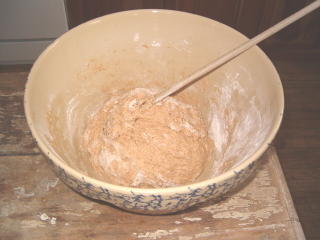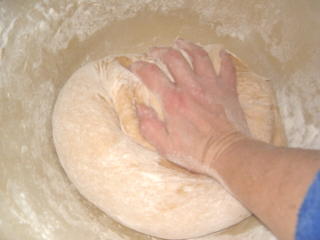Although my grandparents lived in the city of Lockport, New York, Grandma Bunny had grown up in rural Pennsylvania. Grandma remained very much a country housewife, shopping the farmer’s markets and canning large amounts of tomatoes, peaches, jams, and jellies. Like everyone, my grandparents had struggled during the Depression. Grandpa Lee talked more about the Depression years towards the end of his life, around 1980, as he saw the US national debt rise to what was then an historic high. He worried that the economy would crash again, only this time people would suffer more because they didn’t have the practical skills in raising food and livestock that his generation had grown up with. “Even in the city,” he told me, “people knew how to feed themselves. Even in downtown apartments you saw people with chickens and goats on their fire escapes.” Those conversations have resonated through my life and I have made it a game to see how much I could “feed myself” instead of shopping at the supermarket.
When I was about fifteen, I asked Grandma Bunny to teach me how to bake bread. Curiously, she refused to teach me herself, but she did give me my first cookbook on the subject, Bake Your Own Bread, by Floss and Stan Dworkin. It was a good book with lots of recipes, a thorough description of techniques, and science and dietary advice that was ahead of its time. Even so, I found it hard to successfully navigate the passage between batter and dough. Either I was up to my elbows in sticky dough or I was arm wrestling with a stiff dough that was destined to rise no higher than a doorstop.

You can probably figure out that the cause of the first condition is too much liquid and the cause of the second condition is too much flour. So why don’t recipes just tell you exactly how much flour to use? Because they can’t. If your flour is older, it will absorb more liquid. If the weather is humid, it will absorb less. How you store your flour, whether you shake the cup as you measure, it all makes the process too unpredictable. Although it is initially hard to master, once you have experience turning a wet batter into kneadable dough is a skill that you never lose.
We have already seen several tricks of the trade:
• That glop of shortening that we added to the batter will help make the bread fine grained and tender, but it will also make the dough less likely to stick to your hands. If you need to cut out all fat, you can eliminate the shortening, after you get a little experience with baking.
• Use bread flour for at least some of the flour. A cup of semolina flour (also called pasta flour) used as part of the 3 cups of flour in the batter will help make the dough kneadable.
• Take your time while adding flour to give it time to absorb the liquid. If you have small children around you have guaranteed interruptions. If not, take a break to put laundry in the dryer or check your email.
I usually use about 4-5 cups total whole wheat flour and then switch to white flour. The white flour absorbs less liquid so I am less apt to use too much. Stirring thoroughly after each cup of flour, I find that as the dough gets stiffer I am stirring less and folding more. With a strong wooden spoon I can turn the dough in the bowl and fold it over on itself, sort of like kneading without getting my hands into it yet. Already there are drier looking bits of dough on the sides of the bowl; I scrape these down and into the wetter center of the dough. Eventually I am mostly just turning the dough over on itself and only occasionally adding flour. This is a good time to take one more short break and let the dough get used to itself again.
A word about work surfaces. To do this work comfortably you need to set your bowl on a surface that is a tad lower than hip height. Unless you are very tall, this will mean your kitchen table, not the kitchen counter. My kitchen table is ridiculously rustic, so I push the tablecloth back and lay down a dishtowel to keep the bowl from sliding. I have an 18in by 24 in piece of Corian that I lay over the dishtowel to finish kneading on. If I had a regular Formica tabletop I would just knead on the table.
When I come back to the dough after 5 or 10 minutes it is ready for hands-on kneading. Whether I knead on the table or in the bowl, the action is the same: flatten the dough with the heels of my hands, then fold it over on itself, turn it a little, then flatten, fold and turn again. At first I need to keep putting flour on my hand to keep the dough from sticking, later it gets to be moist, not sticky so my bare hands are fine.

It is impossible to hand knead standard bread dough too long. I usually look at the clock once the dough stops sticking and then try to keep up a good rhythm for 5 or ten minutes. Time spent kneading is very much like time spent in deep thinking. You stretch thoughts and fold them over on themselves until myriad elements take on a new identity of their own. If I am pressed for time I will knead for less time, but I know I’m gambling. Kneading develops the gluten that will make the loaves rise with strength; insufficient kneading makes loaves that tend to fall if you sneeze at them.
After kneading it is time to let the dough rise. If I am kneading on the table, I just invert the bowl over the dough and leave it alone. If I am kneading in the bowl, I leave it in the bowl, but cover the bowl with my Corian board or a cookie sheet to keep the dough from drying out.

2 comments:
this is a test
Post a Comment